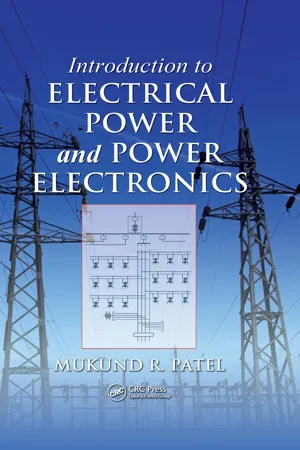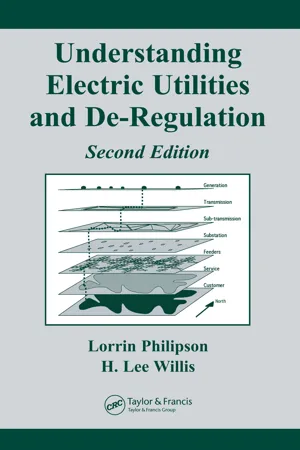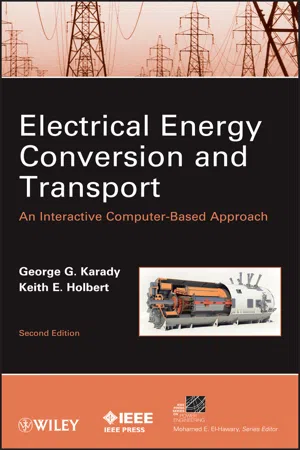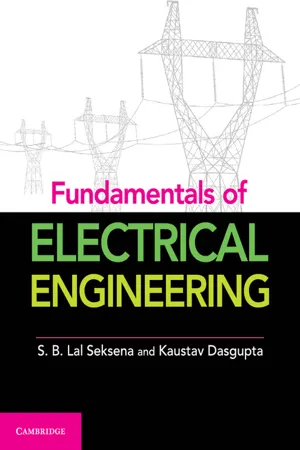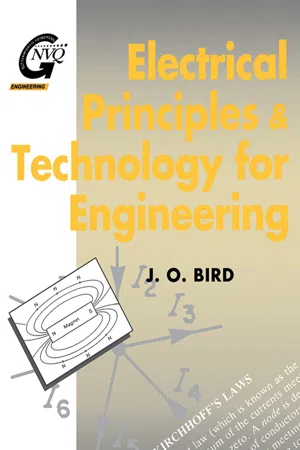Physics
3 Phase Generator
A 3 phase generator is a type of electrical generator that produces three alternating currents, typically 120 degrees out of phase with each other. This design allows for a more constant and smoother power output compared to single-phase generators. It is commonly used in industrial and commercial applications to power large machinery and equipment.
Written by Perlego with AI-assistance
Related key terms
1 of 5
12 Key excerpts on "3 Phase Generator"
- Available until 25 Jan |Learn more
- Turan Gonen(Author)
- 2011(Publication Date)
- CRC Press(Publisher)
18 Electrical Machines with MATLAB transmission, distribution, and heavy-power utilization of electrical energy are done using three-phase systems. A three-phase system is supplied by a three-phase generator (i.e., alternator ), which consists essentially of three single-phase systems displaced in time phase from each other by one-third of a period, or 120 electrical degrees. The advantages of three-phase systems over single-phase systems are as follows: • Less conductor material is required in the three-phase transmission of power and therefore it is more economical. • Constant rotor torque and therefore steady machine output can be achieved. • Three-phase machines (generators or motors) have higher efficiencies. • Three-phase generators may be connected in parallel to supply greater power more easily than single-phase generators. Figure 2.1a shows the structure of an elementary three-phase and two-pole ac generator (also called an alternator ). Its structure has basically two parts: the stationary outside part which is called the stator and the rotating inside part which is called the rotor . The field winding is located on the rotor and is excited by a direct current source through slip rings located on the common shaft. Thus, an alternator has a rotating electromagnetic field; however, its stator windings are stationary . The elementary generator shown in Figure 2.1a has three identical stator coils ( aa', bb' , and cc' ), of one or more turns, displaced by 120° in space with respect to each other. If the rotor is driven counterclockwise at a constant speed, voltages will be generated in the three phases according to Faraday’s law, as shown in Figure 2.1b. Notice that the stator windings constitute the armature of the generator (unlike dc machines where the armature is the rotor). Thus, the field rotates inside the armature. Each of the three stator coils makes up one phase in this single generator. - eBook - ePub
Electric Energy
An Introduction, Third Edition
- Mohamed A. El-Sharkawi(Author)
- 2012(Publication Date)
- CRC Press(Publisher)
Chapter 8Three-Phase Systems
High-power equipment such as generators, transformers, and transmission lines are built as three-phase equipment. The three-phase system has many advantages over the single-phase system; the most important ones are as follows:- Three-phase systems produce a rotating magnetic field inside the alternating current (ac) motors and, therefore, cause the motors to rotate without the need for extra controls. Since electric motors constitute the majority of electric energy consumed worldwide, having a rotating magnetic field is a very important advantage of three-phase systems. The theory of rotating fields is explained in Chapter 12.
- Three-phase generators produce more power than single-phase generators of equivalent volume.
- Three-phase transmission lines transmit three times the power of single-phase lines.
- Three-phase systems are more reliable; when one phase is lost, the other two phases can still deliver some power to the loads.
8.1 Generation of Three-Phase Voltages
According to Faraday’s law, when a conductor cuts magnetic field lines, a voltage is induced across the conductor. The synchronous generator uses this phenomenon to produce a three-phase voltage. A simple schematic of the generator is shown in Figure 8.1 and a more detailed analysis of the machine is given in Chapter 12. The generator consists of an outer frame called stator and a rotating magnet called rotor . At the inner perimeter of the stator, coils are placed inside slots. Each of the two slots separated by 180° houses a single coil (a–a ′ , b–b ′ , or c–c ′ ). The coil is built by placing a wire inside a slot in one direction (e.g., a ), and winding it back inside the opposite slot (a ′ ). In Figure 8.1 , we have three coils; each is separated by 120° from the other coils.Figure 8.1A three-phase generator.Now let us assume that the magnet is spinning clockwise inside the machine by an external prime mover. The magnetic field then cuts all coils and, therefore, induces a voltage across each of them. If each coil is connected to a load impedance, a current would flow into the load, and the generator produces electric energy that is consumed by the load. The dot inside the coil indicates a current direction toward the reader, and the cross indicates a current in the opposite direction. - Mukund R. Patel(Author)
- 2012(Publication Date)
- CRC Press(Publisher)
61 3 AC Generator Nearly all electrical power in the world is generated by the three-phase synchro-nous generator, which is also known as the ac generator or the alternator. It con-sists of three stationary coils (called the stator, armature, or phase coils), which are physically separated in space by 120° from each other, and a rotor with dc coil that produces the dc magnetic field. Both the stator and rotor coils are individually embedded in ferromagnetic cores with an air gap that is consistent with the electri-cal and mechanical design requirements. Figure 3.1 is a simplified cross section of a three-phase generator with three stator coils and salient poles on the rotor. A thermodynamic prime mover drives the rotor, which generates voltage in each phase of the three identical stator coils. The three phase voltages are equal in mag-nitude but 120° out of phase in time (or in ω t , to be precise). The stator coils are usually connected in three-phase Y . That way, the conductors in the stator slots need to have insulation to the ground for only 1/√3 = 0.577 or 57.7% of the line voltage; hence, more conductor can be packed in the slots. In the conventional generator, the dc excitation field current comes from a small separate exciter via slip rings and carbon brushes. One mechanical revolution of a two-pole rotor generates one electrical cycle (360 electrical degrees) in the stator coil voltage. In a four-pole rotor, one mechanical revolution generates 4/2 = 2 electrical cycles (2 × 360 electrical degrees). A rotor with P number of poles driven at n rpm generates P /2 × ( n /60) electrical cycles per second. Therefore, the generator frequency is given by f P n n p = ⋅ = ⋅ 2 60 120 cycles/second (hertz). (3.1) The prime mover must drive the generator at a constant speed to generate power at a constant frequency (60 Hz in the United States and 50-Hz in Europe). We also note here for later use that with a P -pole rotor, one mechanical degree = P /2 electrical degrees.- H. Lee Willis, Lorrin Philipson(Authors)
- 2018(Publication Date)
- CRC Press(Publisher)
One revolution of the rotor thus produces a single back and forth pulsation of current (a cycle ) in each loop. Timing of the rise and fall of current in each phase is slightly different, separated by the time it takes the rotor to spin 1/3 revolution, as shown at the right. Why three phases and not two or four? There is no special reason why three phases are used in power systems instead of two, or four, or six. Sometimes, engineers or scientists will claim that the number three is the closest integer to pi (3.14159 . . .), or the base of the natural logarithm system (2.78182 . . .), as if this has some special significance, but it doesn’t. The fact of the matter is that the first few electric generators, built near the end of the 19th century, had three-phase loops in them, probably because three was seen as a good compromise between two, which would leave a perceivable gap on each side of the generator, and four or more, which lead to manufacturing complexity, a real issue before the advent of standardized parts and assembly line production. Since three phases proved reasonably efficient and easy enough to work with, it became a de facto standard and then the official one, until today all power systems are standardized on three phases. In 156 Chapter 6 very rare cases, often for esoteric special reasons, six-phase transmission lines may be built, and special generators or equipment are used in certain industrial processes that require nine, twelve, or even fifteen-phase power. In short, though, power systems have three phases just because they do. 6.2 ELECTRIC GENERATING SYSTEMS Power distributed by an electric utility is produced by electric generators, which convert some other form of energy into electricity. These original sources of energy can be fossil fuels, i.e., coal, oil, and natural gas, or energy released by the fissioning of radioactive materials, by falling water in hydro-electric plants, or by energy taken from sunlight, wind, or geothermal sources.- eBook - ePub
- C R Robertson, Christopher Robertson(Authors)
- 2010(Publication Date)
- Routledge(Publisher)
Chapter 3Three-Phase A.C. Circuits
Learning Outcomes This chapter introduces the concepts and principles of the three-phase electrical supply, and the corresponding circuits. On completion you should be able to:1 Describe the reasons for, and the generation of the three-phase supply.2 Distinguish between star (3 and 4-wire) and delta connections.3 State the relative advantages of three-phase systems compared with single-phase-systems.4 Solve three-phase circuits in terms of phase and line quantities, and the power developed in three-phase balanced loads.5 Measure power dissipation in both balanced and unbalanced three-phase loads, using the 1, 2 and 3-wattmeter methods, and hence determine load power factor.6 Calculate the neutral current in a simple unbalanced 4-wire system.3.1 Generation of a Three-Phase Supply
In order to understand the reasons for, and the method of generating a three-phase supply, let us firstly consider the generation of a single-phase supply. Alternating voltage is provided by an a.c. generator, more commonly called an alternator. The basic principle was outlined in Fundamental Electrical and Electronic Principles, Chapter 5 . It was shown that when a coil of wire, wound on to a rectangular former, is rotated in a magnetic field, an alternating (sinusoidal) voltage is induced into the coil. You should also be aware that for electromagnetic induction to take place, it is the relative movement between conductor and magnetic flux that matters. Thus, it matters not whether the field is static and the conductor moves, or vice versa.For a practical alternator it is found to be more convenient to rotate the magnetic field, and to keep the conductors (coil or winding) stationary. In any rotating a.c. machine, the rotating part is called the rotor, and the stationary part is called the stator. Thus, in an alternator, the field - eBook - PDF
Electrical Energy Conversion and Transport
An Interactive Computer-Based Approach
- George G. Karady, Keith E. Holbert(Authors)
- 2013(Publication Date)
- Wiley-IEEE Press(Publisher)
145 Practically all electrical energy generation and transmission systems use a three-phase circuit. The three-phase energy is transported through three or four conductors to large customers. Only the small household and light commercial loads are supplied by a single phase. The major advantage of the three-phase system is the efficiency of power transmission. Another advantage is the generation of constant torque, which reduces vibration, for rotating machines. This is particularly important for industries with large motors. In addition, the three-phase generator efficiency is higher than a single-phase unit. A three-phase transmission line carries three times the power of a single-phase line while requiring practically the same right-of-way. These advantages resulted in the worldwide use of three-phase circuits for electric power generation, transmission, and distribution. A polyphase system or circuit utilizes alternating current (ac) sources generating at the same frequency but with different phases. An example includes the use of six- phase and 12-phase systems to supply power to large rectifiers. This chapter presents the basis of the three-phase electric transmission system; explains the wye and delta connections; and introduces the per-unit system frequently used in power engineering. This chapter also details the calculation of voltage, current, and power in three-phase wye and delta systems, and discusses three-phase power measurements. 4 THREE-PHASE CIRCUITS Electrical Energy Conversion and Transport: An Interactive Computer-Based Approach, Second Edition. George G. Karady and Keith E. Holbert. © 2013 Institute of Electrical and Electronics Engineers, Inc. Published 2013 by John Wiley & Sons, Inc. 146 THREE-PHASECIRCUITS 4.1. THREE-PHASE QUANTITIES This book only addresses balanced three-phase systems unless stated otherwise. - No longer available |Learn more
Wiley Survival Guides in Engineering and Science
A Conceptual Introduction
- Alexandra von Meier(Author)
- 2006(Publication Date)
- Wiley-IEEE Press(Publisher)
Because complex, real, and reactive power all have the same physical dimension (energy per time), despite their different labels (VA, watts, and VARs) for identifi- cation purposes, they can usefully be combined in a phasor diagram. Indeed, Figure 3.12 is precisely such a diagram, except that, when introducing it, we did not mention any implicit rotation of the arrows, nor is it necessary to retain the visual image of rotation in order to apply the diagram for calculation purposes in practice. Considering the importance, simplicity, and explanatory richness of that very basic drawing, we can appreciate why phasors are an electrical engineer’s most essential tool for visualizing a.c. power. 84 AC POWER & CHAPTER 4 Generators An electric generator is a device designed to take advantage of electromagnetic induction in order to convert movement into electricity. The phenomenon of induction (introduced in Section 1.5.4) can be summarized as follows: an electric charge, in the presence of a magnetic field in relative motion to it—either by dis- placement or changing intensity—experiences a force in a direction perpendicular to both the direction of relative motion and of the magnetic field lines. Acting on the many charges contained in a conducting material—usually, electrons in a wire—this force becomes an electromotive force (emf ) that produces a voltage or potential drop along the wire and thus causes an electric current (the induced current ) to flow. A generator is designed to obtain an induced current in a conductor (or set of con- ductors) as a result of mechanical movement, which is utilized to continually change a magnetic field near the conductor. The generator thus achieves a conversion of one physical form of energy into another—energy of motion into electrical energy— mediated by the magnetic field that exerts forces on the electric charges. - S. B. Lal Seksena, Kaustuv Dasgupta(Authors)
- 2017(Publication Date)
- Cambridge University Press(Publisher)
As we have 120 0 spatial distribution of R – R', B – B' and Y – Y' coils, the phase difference will also be 120 0 from each other. So such a generator generates three phase AC voltages with 120 0 phase difference between each phase. Fig. 7.4a, b and c: Generation of three phase voltages I t 1 Y Y B N S R B R II t 2 Y Y B N S R B R Y Y B N S III t 3 R B R Three Phase System 335 7.4 Three Phase Load: Balanced and Unbalanced Three Phase We have known that a generator having 120 0 spatially distributed coils generates three phase voltage. The load is connected to this voltage source and will draw three phase current. Some loads are three phase load. These loads draw current from all three phases by itself. An induction motor (will be discussed later) is an ideal example of three phase load. A three phase transformer also draws three phase current in its primary windings. Other major loads (like domestic or electronic loads) are basically single phase load. These draw current from one of the phases of three phase supply. We generally connect the equal amount of single phase load to each phase of the three phase voltage source. For example, your house may consume the power from R phase and your neighbors will be supplied by Y and B phase. All loads are calculated and all the houses are distributed amongst three phases. So there could be two types of three phase loads. If the load draws equal current from all three phases then the load is called a balanced load. A balanced three phase load can be defined as, When the three phase load draws the phase currents all currents are same in both magnitude and phase, the load is known as balanced three phase. It means in balanced three phase the current in each phase winding, same magnitude and same phase difference with respect to respective voltages. If either phase angle or magnitude difference for different phases it called an unbalanced three phase.- eBook - PDF
- Charles A. Gross, Thaddeus A. Roppel(Authors)
- 2012(Publication Date)
- CRC Press(Publisher)
3 1 The word “phase” as used in electrical engineering can be confusing . Most commonly, it means “phase angle,” as in reference to the phase of a voltage or current . Sometimes it refers to a winding , such as a three-phase motor, transformer, or generator . Here, “phase” means “conductor,” but as differentiated from a “neutral,” which is also a conductor . 2 In practice, no N-phase system is ever exactly “balanced .” However, in normal operation, N-phase systems are nearly balanced, and analysis based on this assumption is close enough for most engi-neering purposes . Analysis of unbalanced operation is justified in some cases, but is considerably more complicated and beyond the scope of our study . 3 Electrical grounding means connection to the earth, or any large conducting structure that is desig-nated to be “ground .” For example, for an automotive system, ground is the chassis of the vehicle; for an aircraft system, the airframe; for a ship, the hull; and so on . 159 Electrical Generation and Transmission The balanced phase voltages are v t V t V t v t V t an bn ( ) cos( ) cos( ) ( ) cos( max max = = ⋅ ⋅ = ω ω ω 2 -° = ⋅ ⋅ -° = + ° 120 2 120 120 ) cos( ) ( ) cos( ) max V t v t V t cn ω ω = ⋅ ⋅ + ° 2 120 V t cos( ) ω Source Phase a Phase b Phase c Neutral n Load + + + – – I a – I b – I c – V an – V bn – V cn – – (a) The basic three-phase circuit 2000 1600 1200 an bn cn 800 400 –400 vabc, iabc in kV, A –800 –1200 –1600 –2000 ω t in Degrees (b) Phase Voltage Plots: sequence abc. 0 30 60 90 120 150 180 210 240 270 300 330 360 0 FIGURE 4.3 The basic three-phase situation. (Continued on p. 160). Fundamentals of Electrical Engineering 160 and are plotted in Figure 4 .3b . The corresponding phasors are V V V V V V an bn cn = ∠ ° = ∠ -° = ∠ + ° 0 120 120 The phasor diagram of Figure 4 .3c shows the relationships between phasor voltages in the balanced case . - eBook - PDF
Electrotechnics N4 Student's Book
TVET FIRST
- SA Chuturgoon(Author)
- 2021(Publication Date)
- Troupant(Publisher)
165 Alternating-current (AC) theory TVET FIRST 3 Module Overview of Module 3 AC generators are used to generate electricity at power stations. All domestic and industrial consumers are supplied with alternating currents. These currents reverse their direction of flow many times per second and at regular intervals, and can be represented by a sine wave. In this module we will learn how AC quantities are generated, calculated and represented. We will also explore power and impedance in AC circuits. - eBook - ePub
- Muhammad H. Rashid(Author)
- 2015(Publication Date)
- Academic Press(Publisher)
10.6 Advantages and disadvantages of three-phase supply 20510.6.1 Advantages20510.6.2 Disadvantages20510.7 Summary206Problems 206References 20810.1. Introduction
The three-phase system is an economical way of bulk power transmission over long distances and for distribution. The three-phase system consists of a three-phase voltage source connected to a three-phase load by means of transformers and transmission lines. Two types of connections are possible, namely delta (∆) connection and star or wye (Y) connection. The load and the source can be either in delta or star. The transmission line will be in delta connection. Normally the power system is operated in balanced three-phase condition. Most of the bulk loads such as industrial loads are three-phase balanced loads in nature. However, when there is a mix of single-phase and three-phase loads such as residential loads, the load will be unbalanced. Nevertheless, an unbalanced load can be resolved into a set of more than one balanced system. Hence, the analysis of a balanced system at steady state will be enough to understand three-phase systems.10.2. Generation of three-phase voltages
The bulk of electricity is generated using three-phase alternating current (AC) generators also known as alternators. The AC generators are driven by hydroturbines, gas turbines, steam turbines, or internal combustion engines. AC generators have three separate windings distributed around the inner periphery of the stator [1] . The three windings corresponding to three phases of the system are electrically separated by 120°. The rotor consists of field windings or electromagnets and is rotated at synchronous speed by the prime mover. The rotatory magnetic field cuts the windings in the stator and according to Faraday’s law [1 ,2 ] voltages are induced in these windings.The three-phase windings are designed such that the induced three-phase voltages are sinusoidal, have same frequency, same peak voltage, and are phase displaced by 120°. The three-phase voltages under balanced conditions are defined as in (10.1) and the waveforms are shown in Figure 10.1 - John Bird(Author)
- 2013(Publication Date)
- Butterworth-Heinemann(Publisher)
fl R Induced EMF 9 0 90· sf R ied 1 270* / 3 6 θ · Figure 16.1 206 THREE-PHASE SYSTEMS 16.2 Three-phase supply A three-phase supply is generated when three coils are placed 120° apart and the whole rotated in a uniform magnetic field as shown in Fig. 16.2(a). The result is three independent supplies of equal voltages which are each displaced by 120° from each other as shown in Fig. 16.2(b). (a) nduced EMF f 0 / N / / / f s . / / . / 90* / 1θθ· / 270* /36CT v γ y 1 120' ' 12θ· ] 120* (b) Figure 16.2 (i) The convention adopted to identify each of the phase voltages is: R-red, Y-yellow, and B-blue, as shown in Fig. 16.2. (ii) The phase-sequence is given by the sequence in which the conductors pass the point initially taken by the red conductor. The national standard phase sequence is R, Y, B. A three-phase a.c. supply is carried by three conductors, called iines', which are coloured red, yellow and blue. The currents in these conductors are known as line currents (/ L ) and the p.d.s between them are known as line voltages (V L ). A fourth conductor, called the neutral (coloured black, and connected through protective devices to earth), is often used with a three-phase supply. If the three-phase windings shown in Fig. 16.2 are kept independent then six wires are needed to connect a supply source (such as a generator) to a load (such as a motor). To reduce the number of wires it is usual to interconnect the three phases. There are two ways in which this can be done, these being (a) a star connection, and (b) a delta, or mesh, connection. Sources of three-phase supplies, i.e. alternators, are usually connected in star, whereas three-phase trans-former windings, motors and other loads may be connected either in star or delta. 16.3 Star connection (i) A star-connected load is shown in Fig. 16.3 where the three line conductors are each connected to a load and the outlets from the loads are joined together at N to form what is termed the neutral point or the star point.
Index pages curate the most relevant extracts from our library of academic textbooks. They’ve been created using an in-house natural language model (NLM), each adding context and meaning to key research topics.


